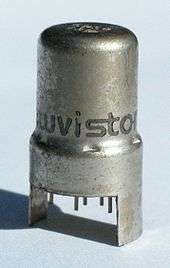Nuvistor


The nuvistor is a type of vacuum tube announced by RCA in 1959. Most nuvistors are basically thimble-shaped, but somewhat smaller than a thimble, and much smaller than conventional tubes of the day, almost approaching the compactness of early discrete transistor casings. Triodes and a few tetrodes were made. The tube is made entirely of metal and ceramic. Making nuvistors requires special equipment, since there is no intubation to pump gases out of the envelope. Instead, the entire structure is assembled, inserted into its metal envelope, sealed and processed in a large vacuum chamber with simple robotic devices.
Nuvistors are among the highest performing small signal receiving tubes. They feature excellent VHF and UHF performance plus low noise figures, and were widely used throughout the 1960s in television sets (beginning with RCA's "New Vista" line of color sets in 1961 with the CTC-11 chassis), radio and high-fidelity equipment primarily in RF sections, and oscilloscopes. They competed with the solid state revolution, and along with GE's Compactron, probably held it at bay for a few years. RCA discontinued their use in television tuners for its product line in late 1971. One famous application was in the Ampex MR-70, a costly studio tape recorder whose entire electronics section was based on nuvistors. Another limited application of this very small tube was in studio-grade microphones from that era, the AKG/Norelco C12a, which employed the 7586, being a good example. It was also later found that, with minor circuit modification, the nuvistor made a sufficient replacement for the obsolete Telefunken VF14 tube, used in the famed Neumann U 47 studio microphone.[1]. Tektronix also used nuvistors in several of its high end oscilloscopes of the 1960s[2], before replacing them later with JFET transistors.
Types
- 7586 - First one released, medium mu triode
- 7587 - Sharp cutoff tetrode
- 8056 - triode for low plate voltages
- 8058 - triode, with plate cap & grid on shell, for UHF performance
- 7895 - 7586 with higher mu
- 2CW4 - Same as type 6CW4, but with a 2.1 volt / 450 milliampere heater. Used in television receivers with series heater strings
- 6CW4 - high mu triode, most common one in consumer electronics
- 6DS4 - remote cutoff 6CW4
- 6DV4 - medium mu, intended as UHF oscillator, shell sometimes gold plated
- 8393 - medium mu, used in Tektronix scopes (12.6 volt filament)
- 13CW4 - same as 6CW4, but with 12.6 Volt / 230 milliampere heater
References
- ↑ Telefunken: TELEFUNKEN U47M (EF14)
- ↑ http://w140.com/tekwiki/wiki/Nuvistor TekWiki Nuvistor article
External links
| Wikimedia Commons has media related to Nuvistors. |